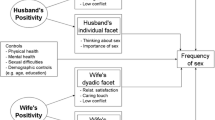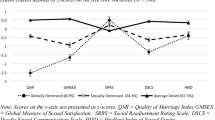Abstract
The present study was designed to investigate the relationship experience of males and females who do not conform to sex-typical orientations to intimacy. One hundred sixty-three couples' and 88 nondating singles' (total N=414) responses to the Relationship World Index—Version 2 (RWI-2) were analyzed via discriminant analysis to determine if subjects' sex could be predicted accurately upon the basis of their RWI-2 scores. One discriminant function was found which was significant by the Wilks' lambda test [x2(60)=140.57, p<.001]; the procedure correctly classified 76% of the respondents. Those who were classified correctly were considered sex-typical and the remaining 24% of the sample was considered non-sex-typical in their orientations to intimacy. Additional analyses using data from a 6-month longitudinal study located qualities which significantly distinguished sex-typical from non-sex-typical subjects and couples in which at least one member was non-sex-typical from couples in which both members were classified as sex-typical.
Similar content being viewed by others
References
Bem, D., & Funder, D. Predicting more of the people more of the time: Assessing the personality of situations. Psychological Review, 1978, 85, 485–501.
Bem, S. Sex role adaptability: One consequence of psychological androgyny. Journal of Personality and Social Psychology, 1975, 4, 634–643.
Berger, P., & Luckmann, T. The social construction of reality: A treatise in the sociology of knowledge. New York: Anchor Books, 1967.
Bernard, J. The future of marriage, New York: World, 1972.
Blaker, R., & Pederson, T. Control and self-confidence as reflected in sex-bound patterns of communication: An experimental approach. Acta Sociologica, 1980, 23, 33–53.
Buchanen, D., Juhnke, R., & Goldman, M. Violation of personal space as a function of sex. Journal of Social Psychology, 1976, 99, 187–192.
Chodorow, N. Oedipal asymmetries and heterosexual knots. Social Problems, 1976, 23, 454–468.
Daly, M., Wilson, M., & Weghorst, S. Male sexual jealousy. Ethology and Sociobiology, 1982, 3, 11–27.
Dawkins, R. The selfish gene. Oxford: Oxford University Press, 1976.
Derlega, V., & Chaikin, A. Norms affecting self-disclosure in men and women. Journal of Consulting and Clinical Psychology, 1976, 44, 376–380.
Fine, G. Small groups and culture creation: The idioculture of little league baseball teams. American Sociological Review, 1979, 44, 735–745.
Foa, U., & Foa, E. Societal structures of the mind. Springfield, IL: Charles C Thomas, 1974.
Freud, S. A general introduction to psychoanalysis. New York: Pocket Books, 1920/1963.
Hawkins, J., Weisberg, C., & Ray, D. Spouse differences in communication style: Preference, perception, behavior. Journal of Marriage and the Family, 1980, 42, 585–593.
Hill, C., Rubin, Z., & Peplau, L. Break-ups before marriage: The end of 103 affairs. Journal of Social Issues, 1976, 32, 147–168.
Hill, C., Rubin, Z., Peplau, L., & Willard, S. The volunteer couple: Sex differences, couple commitment, and participation in research on interpersonal relationships. Social Psychology Quarterly, 1979, 42, 415–420.
Hoffman, M. Sex differences in empathy and related behaviors. Psychological Bulletin, 1977, 84, 712–722.
Hollingshead, A., & Redlich, F. Social class and mental illness. New York: John Wiley, 1958.
Holtzner, B., & Marx, J. Knowledge application: The knowledge system in society. Boston, MA: Allyn and Bacon, 1979.
Isenhart, M. An investigation of the relationship of sex and sex roles to the ability to decode nonverbal cues. Human Communication Research, 1980, 6, 309–318.
Jourard, S. Self-disclosure: An experimental analysis of the transparent self. New York: Wiley-Interscience, 1971.
Jung, C. Psyche and symbol. New York: Anchor Books, 1958.
Kelley, H., & Thibaut, J. Interpersonal relations: A theory of interdependence. New York: John Wiley, 1978.
Kenevan, P. Eros, logos and androgyny. Psychological Perspectives, 1981, 12, 8–21.
Kravetz, D., & Jones, L. Androgyny as a standard of mental health. American Journal of Orthopsychiatry, 1981, 51, 502–509.
Levinger, G., & Senn, D. Disclosure of feelings in marriage. Merrill-Palmer Quarterly, 1967, 13, 237–249.
Lewis, R. The dyadic formation inventory: An instrument for measuring heterosexual couple development. International Journal of Sociology of the Family, 1973, 2, 207–216.
Locke, H., & Wallace, K. Short marital adjustment and prediction tests: Their reliability and validity. Marriage and Family Living, 1959, 21, 251–255.
Mehrabian, A. Significance of posture and position in the communication of attitude and status relationships. Psychological Bulletin, 1969, 71, 359–372.
Murstein, B. Who will marry whom? Theories and research in marital choice. New York: Springer, 1976.
Nguyen, T., Heslin, R., & Nguyen, M. The meanings of touch: Sex differences. Journal of Communication, 1975, 25, 92–103.
Rubin, Z., Hill, C., Peplau, L., & Dunkel-Schetter, C. Self-disclosure in dating couples: Sex roles and the ethic of openness. Journal of Marriage and the Family, 1980, 42, 305–317.
Safilios-Rothschild, C. Love, sex, and sex roles. Englewood Cliffs, NJ: Prentice-Hall, 1977.
Stephen, T. Orientations to intimacy: Effects of sex and length of relationship. A paper presented at the annual meeting of the Organization for the Study of Communication, Language, and Gender, Athens, Ohio, October 1982.
Stephen, T., & Markman, H. Assessing the development of relationships: A new measure. Family Process, 1983, 22, 15–25.
Stephen, T., Markman, H., & Enholm, D. Correlates of adjustment in steady dating and marital relationships. A paper presented a+ the annual meeting of the International Communication Association, Acapulco, Mexico, May 1980.
Symons, D. The evolution of human sexuality. Oxford: Oxford University Press, 1979.
Trivers, R. Parental investment and sexual selection. In B. Campbell (Ed.), Sexual selection and the descent of man. Chicago: Aldine, 1972.
White, G. Jealousy and perceived motives for attraction to a rival. Social Psychology Quarterly, 1981, 44, 24–30.
Author information
Authors and Affiliations
Rights and permissions
About this article
Cite this article
Stephen, T.D., Harrison, T.M. A longitudinal comparison of couples with sex-typical and non-sex-typical orientations to intimacy. Sex Roles 12, 195–206 (1985). https://doi.org/10.1007/BF00288047
Issue Date:
DOI: https://doi.org/10.1007/BF00288047




